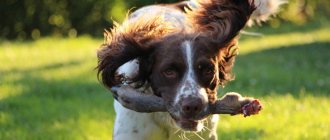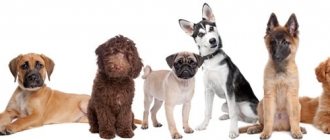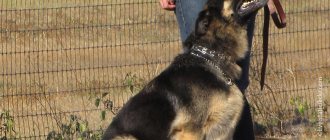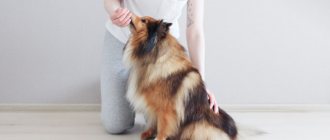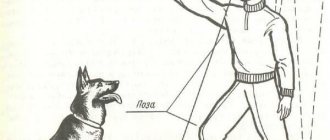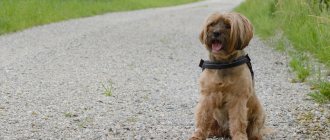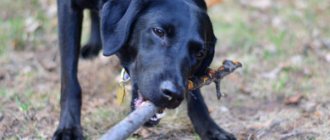Command “Guard!” for dogs It is designed to develop her skill in being in an alert state for a long time and in protecting an object or territory. We will tell you how to teach a dog a command to guard an object or owner. What mistakes should be avoided during training?
Teaching a German Shepherd the “Guard!” command: Photo
A good way to train your dog's guard skills
In order for a pet to learn to protect its owner and his things, it needs to perceive strangers as a potential threat. If the dog is intelligent, this will take several days.
Shepherd dogs, Staffordshire terriers, Dobermans, Rottweilers, black terriers, boxers, etc. are best suited to such training. But even tiny Yorkies can learn to protect their owner.
Training will require a lot of attention, effort and patience from the owner.
Important! Before training, the dog needs to be given a good walk and fed enough.
Unsatisfied physiological needs greatly distract the animal from learning a new command. So, how to teach a dog the command to guard an item? The most successful way is to train a dog to guard in a familiar environment so that it does not get nervous.
Experts recommend choosing a yard for training. The future guard needs to be tied near the house or his own enclosure. A favorite toy or tasty food is placed not far from the dog (within its visibility), the main thing is that the item is of some value to the pet, but is out of reach at that moment. Here you need to correctly calculate the length of the leash, otherwise the dog will happily eat everything or start playing.
Having placed the object close to the dog, the owner must order it to guard and move away. Then a stranger should pass by the treat or toy. The dog most often reacts to such a stranger by barking. When the dog gives a voice, you need to approach him, touch him and give the command “Sit.” This will give the animal a feeling of safety and the importance of protective actions.
All commands are given in a calm voice. It is not recommended to scold or punish a dog if something doesn’t work out. This may discourage the animal from guarding actions.
Note! Exercises with your pet need to be repeated regularly so that the skill is not lost.
The speed of learning depends not only on the breed, but also on the individual characteristics of a particular dog. Therefore, it is impossible to say unambiguously over what period of time a dog will learn to protect its owner and his property. One pet can be trained to guard in a week, and another in a couple of months of regular training.
Classes on teaching the command “Guard”
Worth knowing!
If the dog must guard a large but unfenced area, then it should be led on a short leash to avoid trouble. After all, they can enter such a site completely by accident, without having bad intentions.
If there are various pets in such an area, then the training process should include teaching the dog not to attack animals.
If there is a need to let the dog off the leash to apprehend an intruder, do this: warn loudly three times that you will be releasing the dog, and if the stranger does not pay attention or shows aggression, then let the dog off the leash.
I give these propecia online recommendations not so much to wolfhound candists, but to owners of private houses. Guarding the house is the first duty of a dog since its domestication by man. Dogs quickly learn what constitutes the owner's property; in a few minutes they know what constitutes the owner's possessions. But some dogs, thanks to the ease of life for dogs now, have lost their sense of ownership.
Learning to protect yourself and your home.
I give these propecia online recommendations not so much to wolfhound candists, but to owners of private houses. Guarding the house is the first duty of a dog since its domestication by man. Dogs quickly learn what constitutes the owner's property; in a few minutes they know what constitutes the owner's possessions. But some dogs, thanks to the ease of life for dogs now, have lost their sense of ownership.
When a dog is still a puppy, everyone is a friend to it, and it is a friend to everyone. If she is allowed to follow this spirit of universal friendship for too long, she will be a poor guard dog .
A dog should have one owner, who would be above all for it, from the very age of puppyhood. This lord and owner must establish his authority from the very first day the puppy appeared at home. OTHERS she loves or tolerates, but for his sake, for the sake of her absolute dictator, she will die, and in family quarrels she reluctantly, of course, must take the side of her master, although at times her master and master are spanked by her father.
I recommend: What breed of dog won the heart of Alexey Vorobyov?
Buy levitra too many owners, too many friends, too many meetings with strangers and visitors dulls the puppy's sense of ownership and spoils it as a guard and guard dog. From the moment he arrives at home as a frightened puppy until he is an old man, one person must look after him, feed him, care for him and train him.
To teach your puppy or dog to be a good guard, stretch her bed - a blanket, rug or bag that has been her place for some time. A few minutes a day of such deprivation, first in play, then with a threat, first from the owner, then from strangers, especially those dressed in rags, will make her aggressive.
Place an object in a specific place. Let the stranger approach crouching, sneaking, secretly. You boldly approach the dog and pat it every few seconds, scolding the stranger as he runs away. If your dog is not overly aggressive, the stranger may fight you to get the dog to come to your aid.
Often buy clomid online a carefree dog can be turned into a wary dog if given less freedom. During training, tether her at night or for a significant part of the day in a place where she cannot see what is happening around her. Have someone make a strange noise around her, such as dragging something on the ground or scratching on the wall or slamming doors.
If your dog must guard at night, let him do his job on an empty stomach.
Dogs have two natural habits that correspond well to human habits: it lies in the sun after eating and sleeps, since a dog with a full stomach does what every person does - stretches slowly, goes to sleep and forgets all the light for a while, give heavy daytime food dog at noon if you want him to be your protector in the dark hours of the night when you are sleeping.
The number of priligy online unwary dogs is increasing. The reason is too much feeding, too little exercise, too much affection and lack of training, give lazy and indifferent dogs about two-thirds of the usual diet, keep them outside the house, give them more exercise.
Another reason, which is rarely paid attention to, is that the dog, which is a family pet, is on its feet all day, everyone caresses it, and when the lights are turned off and peace sets in, it is so tired that it falls asleep too soundly. After eating, let the dog be in its place; let it lie there rather than run around among the family, listening to music and conversations.
A good guard and guard dog does not have to be a rushing or vicious dog. Mainly, she must be an alert dog, barking when she hears unfamiliar sounds. A decorative dog can be as wonderful a watchdog as a Great Dane.
When your dog barks, perhaps unnecessarily, do not scold him, tell him to behave calmly, but without any hint of punishment for what he considers his responsibility.
A poorly dressed person, a lame person, a person carrying a bundle, uncertain in his movements, arouses the dog's suspicions and causes him to bark. The dog, which is a poor watchdog under other conditions, begins to bark under these conditions.
Dogs quickly begin to recognize their strongest side. In this they are politicians, and are always quick to join the winner. The dog lunges at the stranger entering the room with a slow, hesitant step. Let the same stranger enter animatedly and confidently. Even a very wary dog may be mistaken in thinking that he is a respected visitor.
At the next stage, let's clearly define what the task is. If you need a dog that will grab the throat of someone who has entered the house, when the owners are absent, and kill him on the spot, then for such a weapon only go to a qualified instructor, and train with him in pairs. My recommendations end at this point.
At the next stage, let's clearly define what the task is. If you need a dog that will grab the throat of someone who has entered the house, when the owners are absent, and kill him on the spot, then for such a weapon only go to a qualified instructor, and train with him in pairs. My recommendations end at this point.
What will I say finally? If you decide to rob a house, firmly, then neither a dog nor an outpost will save you. And if it is necessary that they know about the four-legged guard and are afraid, then the method outlined will be quite sufficient.
Another aspect that has become the spirit of the times and was not familiar to us 10 years ago is social networks. Are you surprised? But in vain. The police have long been warning that criminals are increasingly using social networks to select targets for robbery. We ourselves, with our own hands, provide the following information for public access:
In our troubled times, when the crime situation in the country leaves much to be desired, the increase in the number of robberies of apartments and private houses is completely logical. As the events of recent months have shown, even the presence of a dog in the yard did not always stop robbers. Let's try to figure out together why this happens. In addition, in this article I will try to provide advice to those people who want to improve the security of their home.
I recommend: Dropsy in cats - abdominal ascites: can it be cured, how to save a cat
When considering the protection of territory by a dog, I would immediately like to say that you need to place a warning on the outside of your perimeter that your area is guarded by a dog. Signs must be large and placed in visible places. For history knows examples when a person detained on the territory, chewed a little by a dog and handed over to law enforcement officers, began to weave stories about how “... he got lost, was looking for a friend, was repairing a fence, did not know that there was a dog here...”.
Another aspect that has become the spirit of the times and was not familiar to us 10 years ago is social networks. Are you surprised? But in vain. The police have long been warning that criminals are increasingly using social networks to select targets for robbery. We ourselves, with our own hands, provide the following information for public access:
-the dog’s name, its habits, favorite treat,
- the location of the enclosure on the territory, how it opens, and on what command the dog goes into it.
-what time is she taken for a walk every day and is she absent from the premises?
And remember that the main thing for a well-trained dog is not to be interfered with in performing its functions.
P. S. A few words about electronic security and video surveillance systems. Even if you don’t have the money to buy and install it, its presence on the site can be easily imitated. It is enough to purchase 5-7 faulty surveillance cameras on the radio market and attach them to the site in the most visible places. For this procedure, you can call two or three friends who will come in their car and carry out the “installation” with a smart look.
Take care of yourself! With best wishes, the team of the Phoenix training center.
Alexey Bordunov, head of the training center, senior instructor-trainer, judge of the national category in applied types of training KSU.
Other dog breeds, such as the Airedale Terrier, are also used to guard the home. Although the dog is considered a hunting dog, it is becoming increasingly popular as a home guard. The breeds discussed above are excellent for both defending territory and attacking intruders. It is important to properly train your dog to respond to attempts by ill-wishers to enter the yard.
If the puppy has not yet grown up and has not had its vaccinations, we recommend that you do not take it out into the yard. Also note that up to 3-4 months, especially if it’s cold outside, the dog needs to be kept warm. Naturally, this is fraught with the fact that she will get used to being at home. What to do in this case?
As soon as you understand that you can begin to accustom your dog to living outside, actively begin mastering the enclosure. This must be equipped in advance. Consider what your dog needs to feel comfortable. In the booth, the dog is often very bored. Therefore, you will most likely see your dog on the porch.
To get your dog used to the enclosure, you can gradually start feeding him near his new habitat. This way the pet will have pleasant associations with its new home. You can then place the bowl deeper into the enclosure. As a rule, guard dogs value space. Even if the dog is at a special checkpoint, give him the opportunity to explore the territory, walk and show him what the dog should guard.
Service dog breeds are considered the best in training and control by the owner, Golubev believes. Such dogs are used to search for explosives, search for people, detain violators, search for people in rubble after disasters, and so on. Shepherd dogs are also classified as service dogs.
Despite the fact that Central Asian and Caucasian Shepherds are the best guards, service dogs are easy to train
Service dog breeds are considered the best in training and control by the owner, Golubev believes. Such dogs are used to search for explosives, search for people, detain violators, search for people in rubble after disasters, and so on. Shepherd dogs are also classified as service dogs.
“They are all distinguished by their unpretentiousness, good health, endurance, high learning ability, strong character, self-confidence and fearlessness. That is why they are able to perform work, often in difficult weather conditions, for a long time,” said the dog handler.
Alien command training
Even for domestic decorative dogs, knowledge of the “Alien” command is important. Those pets that are not used for protection also need to be taught a wary attitude towards strangers. More for their own safety, so that they don’t take food from strangers. After all, it is unknown what “filling” such a treat will have.
Guard dogs, upon hearing the command “Stranger,” must take a step forward, covering the owner.
Training begins as early as possible. For classes you will need the help of another person, who will pretend to be a “stranger”. The learning algorithm is as follows.
- The owner holds the dog on a leash or collar.
- The stranger approaches the animal, shouting and waving a stick.
- When a stranger approaches, the owner constantly repeats the word “Stranger.”
- If the dog begins to growl and bark, covering the owner, then you need to praise him. Treats are not given to prevent the pet from choking.
Note! If a dog lies down and covers its muzzle with its paws, then a stranger should quietly approach and painfully pinch its hind paw. The owner at this moment says “Alien”.
Even the most peace-loving or cowardly dog will not tolerate such treatment and will begin to defend itself. Since he will associate the command with the pain of a pinch, the dog will react by growling and barking.
The dog's wariness should not turn into aggression if the stranger does not attack.
A puppy is taught the command “Alien”
General recommendations for beginners
If your dog knows various commands, you will be comfortable going for walks with him. Many of you don’t know how to teach a dog commands, so we wanted to tell you more about it.
The owner can train the pet himself. There are situations when the owner plans to attend various competitions or exhibitions; in such a situation, it is better if a specially trained person is involved in the training.
It all depends on the purpose for which you need to teach the dog various commands. It will take you a long time to learn, so you need to be patient.
From the first days of training, the owner should praise his pet if he performs the tasks correctly. There are situations when the dog refuses to do something, so you need to be strict with your pet during training.
How to train a dog to be aggressive towards other people
To protect your home, you need to teach your dog to vocalize when a stranger enters the yard. A trained animal poses an increased danger to people, so there should be a sign on the gate or fence “Caution! Angry dog".
Only an experienced owner can properly train a dog to be aggressive. For everyone else, it is better to resort to the help of a dog handler. Classes will be held not only for the dog, but also for the owner, because he will have to learn to pacify an aggressive pet.
Training should begin at 4-5 months, after the dog is trained to perform the commands “Alien”, “Come to me”, “Fu”.
During training, the dog handler, teasing the dog, will show him that strangers can be dangerous. Therefore, you need to be wary of them. To calm the dog after such activities, the owner should praise it, caress it and give it a treat.
Important! The owner must speak calmly and not make sudden movements. Then the pet will also quickly calm down and feel safe.
Warning sign “Caution! Angry dog"
Dogs for territory protection
Of course, it is important to take into account the pedigree and innate qualities of the dog. Character and temperament are one of the key factors that determine a dog's behavior strategy in the presence of a threat. If we talk about purchasing a puppy, you should understand that there are both pros and cons to this choice. The benefits are that you can introduce a new behavior strategy to your dog since you are training him for the first time. She has no previous experience either in dealing with people or in protecting territory. Therefore, it is important for you to take into account the fact that attackers are different. The primary thing in training should be that the animal should eventually understand that there are “strangers” and “friends”. The dog is taught this based on his natural instincts of being in a pack.
As a rule, the following dog breeds are selected to guard the territory:
- Akita Inu. Japanese breed of dog for hunting deer and wild boar.
- Alabai. A breed common in Russia. It is also called the Central Asian Shepherd Dog.
- Bullmastiffs are known for being willing to protect their family to the last.
- Caucasian Shepherd Dogs are large dogs whose ability to protect is inherent in their genotype.
- Moscow Watchdog or St. Bernard. It serves as an excellent defender of the territory, which is why it got its name.
- German Shepherd. An intelligent and loyal dog to its owner.
- Rottweiler. A guard dog that guards any yard and is easy to train.
- Sheltie. The history of this breed has many years of herding experience. Now they easily get along with people, defending their premises and estates from intruders.
- South African Boerboel. Designed to protect residential premises and is a guard dog.
- Doberman pinscher. A breed that was developed by crossing a German Pinscher and a Black Terrier. An excellent guard for your home.
- East European Shepherd. Restrained in her behavior, a little stern in appearance. Despite this, he is good with children.
- Ca-de-bo. She is self-possessed, phlegmatic and able to assess the situation before an attack.
- Tibetan Mastiff. He is taught not only to defend the territory. He is also good with children and families.
Of course, these are not the only breeds that you can trust to look after your territory. You can teach your dog to guard the yard yourself or with the help of a dog handler. Of course, you should be patient and try to help the dog understand what is needed from it. Moreover, even ordinary mongrels or purebred breeds can become guards of your home. The important thing is that every dog has instinct. But it can be both a friend and an enemy to a person. So you need to have a trusting relationship with the dog. There are breeds specially bred for such purposes. They have a well-developed protective instinct. There may be several dogs in a protected area. Many breeds get along well in one area. The main thing for you to remember is that dogs can also be jealous and need equal love and attention to them. When raising a guard dog, you need to maintain other qualities in it. Naturally, it is important to develop discipline so that the dog’s aggressiveness is controlled. This is what distinguishes many breeds of service or guard dogs from yard dogs.
How to praise a dog correctly
The tone in which the owner pronounces praise is very important for the pet. It is the tone of voice that expresses a person’s emotions and is well understood by the dog.
The dog is praised immediately after the action is completed. That is, after he barked at a stranger.
The praise doesn't have to be verbose, just saying, "Well done, {animal name}" is enough. A flood of words can confuse a dog.
Other types of rewards for successfully following a command could include treats or petting.
Praise for doing the right thing
Security training
For security training, you need a group that includes four:
1. A dog (at least one year old) that has completed a preliminary training course and is ready to continue training.
2. A dog owner or trainer who knows the basics of training.
3. An assistant trainer, playing the role of a “criminal”, who has the ability to excite the dog (tease it).
4. Group leader or instructor.
Before you begin security training, your dog needs to be tested. Dogs mature at different times. First, you need to make sure that the dog has already learned to grip. Secondly, the dog's defensive abilities are tested. This is where the maturity of the dog is tested.
Teaching a dog to bark at strangers
Many dogs themselves happily bark at strangers. But any “quiet” pet can be taught to vocalize when a stranger appears. Here you will need the help of another person, who will be the object of the dog’s attention. The main condition is that the assistant should not be familiar to the pet.
The animal must be tied, because some dogs may not limit themselves to barking.
With the help of a specialist or on your own, you need to teach the dog to shut up on the command “Fu”. If everything is done correctly, the owner must praise the pet.
Any dog must clearly respond to the owner’s commands
What is a ZKS for dogs?
Unlike UGS, OKD and ZKS for dogs are officially approved types of training required for animals participating in breeding. The basics of protective guard service were developed by domestic dog handlers. The skills acquired after completing the training were actively used among working breeds. Gradually, owners of completely ordinary pets became interested in them. PCL training in dogs is aimed at developing 3 instincts:
- protective, showing when protecting entrusted things and owners;
- social, necessary for adequate interaction with others;
- hunting, used to capture and escort intruders.
After passing the ZKS, animals can participate in search operations, guard prisoners and determine the location of drugs by smell. Despite this, most owners are limited to the skills of protecting the territory and people.
Don't get used to strangers
A dog guarding a house should not trust strangers. This is especially true for food received from the hands of another person. After all, before stealing, criminals either euthanize or poison the dog. Therefore, the animal must clearly divide people into “friends” and “strangers”. You cannot run up to strangers, play, or caress.
In order to achieve this, only the owner or his immediate family should feed the dog. The pet must be taught not to accept any treats from the owner’s guests or strangers on the street. Even if they treat him out of sincere sympathy.
Important! An exception to this rule cannot be made for anyone. Otherwise, the dog may get confused and start accepting food from everyone else. The ban applies not only to treats, but also to toys and other items.
Prohibition of taking food from other people
List of trainable skills
When training, natural aggression is used. Because of this, it is not recommended to train yourself. Mistakes made can lead to excessive aggressiveness or cowardice in the dog, which poses a danger to others. All classes must be conducted under the guidance of an experienced dog handler.
Protection of things and the owner
This skill is indispensable if you don’t have a storage room. In the future, you can entrust your pet with valuable luggage and even a stroller with a child, calmly going to the nearest store for shopping.
Training begins with guarding a small thing. In the future, the skill can be developed up to the protection of a large building and even a secret facility.
Training is structured as follows:
- The owner gives the pet the command “sit” or “lie down”.
- After taking the desired pose, the dog is given an item and commanded “guard.” Immediately after this, the owner leaves the animal's field of view.
- An instructor appears on the site, trying to take away a trusted item. He uses a bait with food, flicks the dog on the nose and lightly hits him on the sides with a twig.
- The subject must show aggression only when attempting to attack a protected item. Strangers on the site passing by should not bother him.
The training program simulates real life situations. As a result, the four-legged pet guards the entrusted object without harm to others.
Item selection
This skill develops the sense of smell, helping to identify objects with the same smell. A developed sense of smell is indispensable when searching for missing people, criminals or dangerous goods.
At the beginning of the test, the dog is introduced to the object using the “sniff” command. Next, he is asked to find another object with an identical smell using the “search” command. The sampling site must be 3 m away from the animal. The pet must smell the correct piece of cloth or piece of wood, choosing from the 5 proposed options, and bring it to the owner.
Detention and escort of the violator
One of the most dangerous trainings involving the capture of a person. Helps to practice the skill of protecting a home in the event of a robbery or family members in the event of a direct attack by an intruder.
Training is divided into 4 stages:
- Detention
. The pet follows the owner on the command “near” or simply sits at his left leg. A trainer dressed in a protective suit suddenly appears and attracts the dog's attention with threatening gestures using a whip. After the word “fas,” the animal takes off and grabs the intruder with a death grip. The trainer commands “fu” and approaches the caught one. - Escort with assassination attempt
. Together with the dog, the owner escorts the intruder, moving behind his back. The pet, having received the “guard” signal, carefully monitors the escort. After 10 steps, the criminal attacks the trainer. An attempt to attack is stopped by the dog without receiving commands. The grip loosens after the starting pistol fires and the word “ugh”. - Search
. The dog carries out the command “sit” or “guard”, supervising the search of the offender and the removal of the whip. - Escort to the police station
. The further hike continues from the side. The trainer commands “near” or “guard”, and at the end of the path he stops the pet with the command “sit”.
In addition to direct capture, the animal helps to disarm, detain or deliver a criminal directly into the hands of law enforcement agencies. Remember that learning on your own may result in injury or inappropriate behavior.
How to develop the right reaction to strangers
After the dog has mastered the “Voice” command, you can move on to learning the correct reaction to strangers. Here it is not even necessary to involve a specialist; classes can be done independently. But you still can’t do without an assistant, because the owner must be next to the guard to monitor his reaction and guide it.
Another person at this moment should make noise from the other side of the door or gate. You can knock, shout, pull the handle. The owner gives the dog the “Voice” command. After the dog starts barking, the command “Guard” follows. The animal must understand that it needs not just to bark, but to be on guard. And, if something happens, rush to protect the owner and his property.
When the dog becomes wary, the owner must signal his assistant to stop making noise. At the same time, the pet must be rewarded with praise or a treat. The training must be repeated until the owner is sure that the dog has learned the command.
What to teach next?
Like any other animal, a dog understands that there are limits to its territory. Having given the dog the opportunity to share space with it, you need to designate an area where the dog can move freely or be tied to a chain. It is also possible to organize a so-called “checkpoint” where the animal will be located. In the first case, the dog has the opportunity to attack. But she is not always taught this, since sometimes only loud barking is enough.
Subsequent training of the dog takes place with the participation of an assistant. You must find a volunteer who agrees to play the role of a criminal. This person approaches the fence, creating a rustling sound. Your task is to alert the dog by shouting the command “guard” to it. To produce a bark, the “voice” command is used. As soon as the dog starts barking, the attacker becomes silent. This way you let the dog know that he is required to scare off the thief. Don't forget to reward your dog.
Defense training from specialists
Training with a dog handler
The process of training a four-legged guard can only be done by an experienced owner. A beginner does not need to undertake independent training, especially if the pet has a difficult character. In this case, turn to professional dog handlers. They will teach both the dog and its owner all the nuances of protection. You need to choose a dog handler based on the following parameters:
- availability of veterinary and canine education;
- positive reviews. It is advisable that these are reviews given by people you know. Flattering words on the Internet should not be completely trusted;
- ease of communication, calmness and confidence. Dogs do not understand scientific words; they do not need an abundance of professional terms. As well as their owners.
It is recommended to attend a trial lesson before paying for the full course. You can also watch another dog being trained. You should definitely ask about teaching methods. If the dog handler is reluctant to answer questions, then it is better to contact another specialist.
Thus, the puppy training process should begin no later than four months. First, the dog learns the commands “Fu”, “Voice” and “Stranger” and only then - “Guard”. A protective dog is necessarily taught to distrust strangers. An owner who does not have sufficient experience or time does not need to undertake training.
What if the dog doesn't want to show aggression?
Quite often, owners are faced with the fact that their pet does not show aggression towards a stranger. But in this case, you should not immediately retreat and use more active methods:
- the assistant does not wave his hands, but tries to attack the owner;
- he tries to take away from the owner a treat intended for the pet;
- “attacking”, the helper lightly hits the dog, not to cause bodily harm, but to provoke aggression.
Dog handlers warn that excessive use of physical violence can have the opposite effect - the dog will become not angry, but cowardly. The assistant is required to have an attentive and careful approach - he must observe the dog’s behavior and, if necessary, stop training. This is done so that the person does not suppress the dog - in this “fight” the animal must always win!
Encouragement is important - for the expected reaction the dog is petted, words of praise are spoken, and a treat is given. But it is advisable not to overdo it with the last point. You can also reinforce the result when walking - the command is pronounced if the pet begins to growl or grin at a passerby. During walks, you can also provoke the dog - ask the assistant to quietly approach the dog when he is not expecting it, and pat him, for example, on the rump. The owner gives the command at this moment.
With the right approach, after some time, the dog develops the necessary reaction - he shows distrust of strangers and does not feel fear when they swing at him.
Teaching your pet the “stranger” command is an event that requires a serious approach. If the owner is not ready for consistent work while observing a number of rules, then there is no point in starting. After all, it is not difficult to harm a puppy’s psyche, but it is not possible to correct the situation in certain situations. No confidence in your own abilities? Then it is better to contact an experienced dog handler.
Source
How to teach a dog the guard command: methods. The procedure for training a dog to guard a house or owner. Train your dog to be mean to strangers. How to properly work out a security command.
The first steps to teaching your dog the “Guard” command
Guard and service dogs are typically trained in many commands. The main ones, such as “sit”, “lie down”, “freeze”, are intended to use them to prepare the animal to perform other commands. But the most important thing that can be achieved by training a dog is to develop endurance in the animal. Therefore, for subsequent education, it can be very useful to set aside 15-30 minutes a day for training. Once you notice that your dog is taking your walks seriously, you can begin to use other commands.
Source
Read also
1. Security of the site. "Listen" command
9. 1. Security of the site. The “listen” command The main questions here are the following: 1) the method of notifying about the danger; 2) complete suppression of barking; 3) training in long-term alertness. The best and easiest way to alert is to use the innate
Calling the dog (basic command “come to me”)
Calling a dog (the main command “come to me”) The purpose of the exercise is to teach the dog to quickly approach the trainer (owner) when called under any circumstances of time and environment. To practice this skill, they are mainly used
Detaining an escaping person (basic command “FAS”)
Detaining an escaping person (the main command is “FAS”) The word “detention” means that a dog is chasing a running away person and somewhat hindering his rapid movement. There are several ways to train a dog to detain a running away person. A dog can be trained
Escorting a detainee (basic command “guard”)
Accompanying a detainee (the main command is “guard”) When a dog has well-developed anger, distrust of strangers and actively goes to apprehend the escaping person, the transition to practicing accompaniment of the detainee is quite simple. A conditioned stimulus for the dog
Defense of the owner by the dog (basic command “FAS”)
Defense of the owner by the dog (the main command “Fas”) After the dog has developed distrust of strangers, developed anger and a strong grip, it is trained to protect its owner. The conditioned stimulus is the command “Fas”, the unconditioned - moments of the dog’s grasp
A dog sampling its owner’s things (the basic command is “sniff”)
The dog selecting his owner’s things (the main command is “sniff”) An exercise for learning to select things belonging to the trainer from a number of other objects is auxiliary for training a search dog. This is the initial stage of more complex exercises in
Nuances and features
During the training process, be sure to take into account your pet’s mood. Skip a planned workout if your dog looks sick or just tired. Your own well-being is equally important. Remember that 10 minutes of exercise three times a day is more than enough.
IMPORTANT!
When learning to give an object, the reward is its return and praise. This distinguishes it from “Fu”, where what is spat out remains strictly on the ground.
Don’t rush to embrace the immensity and move smoothly from simple to complex. If problems arise, be sure to return to the previous step.
Error correction
When leaving the place, use the word “No” and independently return the dog to its original position. Don't try to shout "Place", because this word is necessary for the initial landing. Also, you should not use “To me”, so as not to cause confusion with prohibition and encouragement.
If your pet makes mistakes more and more often, return to the previous stage, reducing the distance or duration of waiting. Remember that the "Wait" command requires strong self-control. Don't demand too much from your pet and let him go at his own pace, without adjusting to other people's expectations.
Do you like the article? 0
